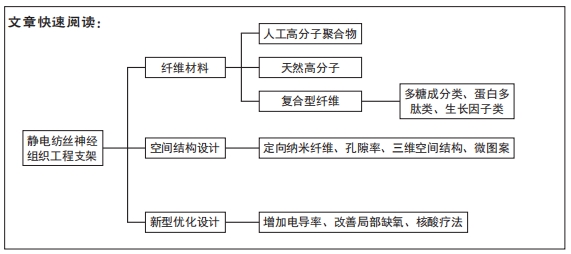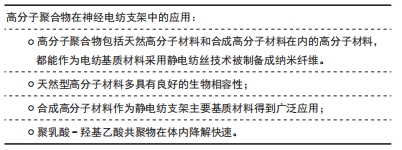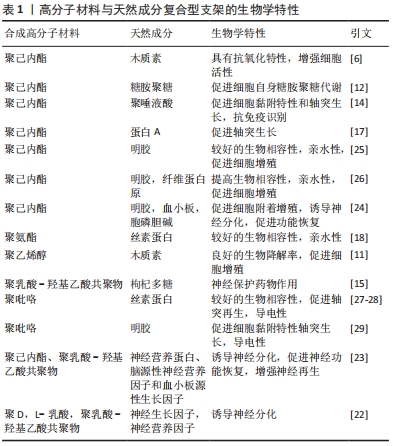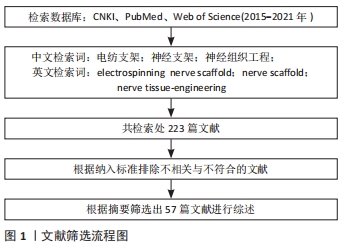[1] AMANI H, KAZEROONI H, HASSANPOOR H, et al. Tailoring synthetic polymeric biomaterials towards nerve tissue engineering: a review. Artif Cells Nanomed Biotechnol. 2019;47(1):3524-3539.
[2] HOUSCHYAR KS, MOMENI A, PYLES MN, et al. The Role of Current Techniques and Concepts in Peripheral Nerve Repair. Plast Surg Int. 2016;2016:4175293.
[3] AMANI H, MOSTAFAVI E, ARZAGHI H, et al. Three-Dimensional Graphene Foams: Synthesis, Properties, Biocompatibility, Biodegradability, and Applications in Tissue Engineering. ACS Biomater Sci Eng. 2019;5(1):193-214.
[4] LAU YT, KWOK LF, TAM KW, et al. Genipin-treated chitosan nanofibers as a novel scaffold for nerve guidance channel design. Colloids Surf B Biointerfaces. 2018;162:126-134.
[5] WANG J, TIAN L, CHEN N, et al. The cellular response of nerve cells on poly-l-lysine coated PLGA-MWCNTs aligned nanofibers under electrical stimulation. Mater Sci Eng C Mater Biol Appl. 2018;91:715-726.
[6] WANG J, TIAN L, LUO B, et al. Engineering PCL/lignin nanofibers as an antioxidant scaffold for the growth of neuron and Schwann cell. Colloids Surf B Biointerfaces. 2018;169:356-365.
[7] WHITEHEAD TJ, AVILA COC, SUNDARARAGHAVAN HG. Combining growth factor releasing microspheres within aligned nanofibers enhances neurite outgrowth. J Biomed Mater Res A. 2018;106(1):17-25.
[8] PALAMÀ IE, ARCADIO V, D’AMONE S, et al. Therapeutic PCL scaffold for reparation of resected osteosarcoma defect. Sci Rep. 2017;7(1): 12672.
[9] SADERI N, RAJABI M, AKBARI B, et al. Fabrication and characterization of gold nanoparticle-doped electrospun PCL/chitosan nanofibrous scaffolds for nerve tissue engineering. J Mater Sci Mater Med. 2018; 29(9):134.
[10] DOS SANTOS FP, PERUCH T, KATAMI SJV, et al. Poly (lactide-co-glycolide) (PLGA) Scaffold Induces Short-term Nerve Regeneration and Functional Recovery Following Sciatic Nerve Transection in Rats. Neuroscience. 2019;396:94-107.
[11] SAUDI A, AMINI S, AMIRPOUR N, et al. Promoting neural cell proliferation and differentiation by incorporating lignin into electrospun poly(vinyl alcohol) and poly(glycerol sebacate) fibers. Mater Sci Eng C Mater Biol Appl. 2019;104:110005.
[12] IDINI M, WIERINGA P, ROCCHICCIOLI S, et al. Glycosaminoglycan functionalization of electrospun scaffolds enhances Schwann cell activity. Acta Biomater. 2019;96:188-202.
[13] MENEZES R, HASHEMI S, VINCENT R, et al. Investigation of glycosaminoglycan mimetic scaffolds for neurite growth. Acta Biomater. 2019;90:169-178.
[14] ZHANG S, WANG XJ, LI WS, et al. Polycaprolactone/polysialic acid hybrid, multifunctional nanofiber scaffolds for treatment of spinal cord injury. Acta Biomater. 2018;77:15-27.
[15] WANG J, TIAN L, HE L, et al. Lycium barbarum polysaccharide encapsulated Poly lactic-co-glycolic acid Nanofibers: cost effective herbal medicine for potential application in peripheral nerve tissue engineering. Sci Rep. 2018;8(1):8669.
[16] PATZKE C, ACUNA C, GIAM LR, et al. Conditional deletion of L1CAM in human neurons impairs both axonal and dendritic arborization and action potential generation. J Exp Med. 2016;213(4): 499-515.
[17] LIN J, CHOOI WH, ONG W, et al. Oriented and sustained protein expression on biomimicking electrospun fibers for evaluating functionality of cells. Mater Sci Eng C Mater Biol Appl. 2021;118:111407.
[18] SHRESTHA S, SHRESTHA BK, LEE J, et al. A conducting neural interface of polyurethane/silk-functionalized multiwall carbon nanotubes with enhanced mechanical strength for neuroregeneration. Mater Sci Eng C Mater Biol Appl. 2019;102:511-523.
[19] WANG ZH, CHANG YY, WU JG, et al. Novel 3D Neuron Regeneration Scaffolds Based on Synthetic Polypeptide Containing Neuron Cue. Macromol Biosci. 2018;18(3). doi: 10.1002/mabi.201700251.
[20] ZHANG K, CHOOI WH, LIU S, et al. Localized delivery of CRISPR/dCas9 via layer-by-layer self-assembling peptide coating on nanofibers for neural tissue engineering. Biomaterials. 2020;256:120225.
[21] CAO X, SHOICHET MS. Investigating the synergistic effect of combined neurotrophic factor concentration gradients to guide axonal growth. Neuroscience. 2003;122(2):381-389.
[22] LIU C, WANG C, ZHAO Q, et al. Incorporation and release of dual growth factors for nerve tissue engineering using nanofibrous bicomponent scaffolds. Biomed Mater. 2018;13(4):044107.
[23] HONG MH, HONG HJ, PANG H, et al. Controlled Release of Growth Factors from Multilayered Fibrous Scaffold for Functional Recoveries in Crushed Sciatic Nerve. ACS Biomater Sci Eng. 2018;4(2):576-586.
[24] SAMADIAN H, EHTERAMI A, SARRAFZADEH A, et al. Sophisticated polycaprolactone/gelatin nanofibrous nerve guided conduit containing platelet-rich plasma and citicoline for peripheral nerve regeneration: In vitro and in vivo study. Int J Biol Macromol. 2020;150:380-388.
[25] BORAH R, INGAVLE GC, SANDEMAN SR, et al. Electrically conductive MEH-PPV:PCL electrospun nanofibres for electrical stimulation of rat PC12 pheochromocytoma cells. Biomater Sci. 2018;6(9):2342-2359.
[26] SAADATKISH N, NOURI KHORASANI S, MORSHED M, et al. A ternary nanofibrous scaffold potential for central nerve system tissue engineering. J Biomed Mater Res A. 2018;106(9):2394-2401.
[27] WANG L, WU Y, HU T, et al. Aligned conductive core-shell biomimetic scaffolds based on nanofiber yarns/hydrogel for enhanced 3D neurite outgrowth alignment and elongation. Acta Biomater. 2019;96:175-187.
[28] ZHAO Y, LIANG Y, DING S, et al. Application of conductive PPy/SF composite scaffold and electrical stimulation for neural tissue engineering. Biomaterials. 2020;255:120164.
[29] NAGHAVI ALHOSSEINI S, MOZTARZADEH F, KARKHANEH A, et al. Improved cellular response on functionalized polypyrrole interfaces. J Cell Physiol. 2019;10.1002/ jcp.28173.
[30] LIN C, LIU C, ZHANG L, et al. Interaction of iPSC-derived neural stem cells on poly(L-lactic acid) nanofibrous scaffolds for possible use in neural tissue engineering. Int J Mol Med. 2018;41(2):697-708.
[31] RAMBURRUN P, KUMAR P, CHOONARA YE, et al. Design and characterisation of PHBV-magnesium oleate directional nanofibers for neurosupport. Biomed Mater. 2019;14(6):065015.
[32] HUANG L, ZHU L, SHI X, et al. A compound scaffold with uniform longitudinally oriented guidance cues and a porous sheath promotes peripheral nerve regeneration in vivo. Acta Biomater. 2018;68:223-236.
[33] SONG SJ, SHIN YC, KIM SE, et al. Aligned laminin core-polydioxanone/collagen shell fiber matrices effective for neuritogenesis. Sci Rep. 2018; 8(1):570.
[34] WU YX, MA H, WANG JL, et al. Production of chitosan scaffolds by lyophilization or electrospinning: which is better for peripheral nerve regeneration? Neural Regen Res. 2021;16(6):1093-1098.
[35] CNOPS V, CHIN JS, MILBRETA U, et al. Biofunctional scaffolds with high packing density of aligned electrospun fibers support neural regeneration. J Biomed Mater Res A. 2020;108(12):2473-2483.
[36] CAO Y, WU T, YUAN Z, et al. Three-dimensional imaging of microvasculature in the rat spinal cord following injury. Sci Rep. 2015;5:12643.
[37] YAO S, YU S, CAO Z, et al. Hierarchically aligned fibrin nanofiber hydrogel accelerated axonal regrowth and locomotor function recovery in rat spinal cord injury. Int J Nanomedicine. 2018;13:2883-2895.
[38] ZHANG L, CHEN S, LIANG R, et al. Fabrication of alignment polycaprolactone scaffolds by combining use of electrospinning and micromolding for regulating Schwann cells behavior. J Biomed Mater Res A. 2018;106(12):3123-3134.
[39] YAN H, WANG Y, LI L, et al. A micropatterned conductive electrospun nanofiber mesh combined with electrical stimulation for synergistically enhancing differentiation of rat neural stem cells. J Mater Chem B. 2020;8(13):2673-2688.
[40] FRANK JA, ANTONINI MJ, ANIKEEVA P. Next-generation interfaces for studying neural function. Nat Biotechnol. 2019;37(9):1013-1023.
[41] AYDEMIR SEZER U, OZTURK YAVUZ K, ORS G, et al. Zero-valent iron nanoparticles containing nanofiber scaffolds for nerve tissue engineering. J Tissue Eng Regen Med. 2020;14(12):1815-1826.
[42] GUO Z, LIANG J, POOT AA, et al. Fabrication of poly (trimethylene carbonate)/reduced graphene oxide-graft-poly (trimethylene carbonate) composite scaffolds for nerve regeneration. Biomed Mater. 2019;14(2):024104.
[43] FANG X, GUO H, ZHANG W, et al. Reduced graphene oxide-GelMA-PCL hybrid nanofibers for peripheral nerve regeneration. J Mater Chem B. 2020;8(46):10593-10601.
[44] MAGAZ A, LI X, GOUGH JE, et al. Graphene oxide and electroactive reduced graphene oxide-based composite fibrous scaffolds for engineering excitable nerve tissue. Mater Sci Eng C Mater Biol Appl. 2021;119:111632.
[45] MAGAZ A, SPENCER BF, HARDY JG, et al. Modulation of Neuronal Cell Affinity on PEDOT-PSS Nonwoven Silk Scaffolds for Neural Tissue Engineering. ACS Biomater Sci Eng. 2020;6(12):6906-6916.
[46] WANG Y, ZHANG Y, ZHANG Z, et al. An injectable high-conductive bimaterial scaffold for neural stimulation. Colloids Surf B Biointerfaces. 2020;195:111210.
[47] HSU CC, SERIO A, AMDURSKY N, et al. Fabrication of Hemin-Doped Serum Albumin-Based Fibrous Scaffolds for Neural Tissue Engineering Applications. ACS Appl Mater Interfaces. 2018;10(6):5305-5317.
[48] THRIVIKRAMAN G, BODA SK, BASU B. Unraveling the mechanistic effects of electric field stimulation towards directing stem cell fate and function: A tissue engineering perspective. Biomaterials. 2018;150:60-86.
[49] ZHAO YH, NIU CM, SHI JQ, et al. Novel conductive polypyrrole/silk fibroin scaffold for neural tissue repair. Neural Regen Res. 2018;13(8):1455-1464.
[50] DU L, LI T, JIN F, et al. Design of high conductive and piezoelectric poly (3,4-ethylenedioxythiophene)/chitosan nanofibers for enhancing cellular electrical stimulation. J Colloid Interface Sci. 2020;559:65-75.
[51] ZHU S, GE J, WANG Y, et al. A synthetic oxygen carrier-olfactory ensheathing cell composition system for the promotion of sciatic nerve regeneration. Biomaterials. 2014;35(5):1450-1461.
[52] MA T, ZHU L, YANG Y, et al. Enhanced in vivo survival of Schwann cells by a synthetic oxygen carrier promotes sciatic nerve regeneration and functional recovery. J Tissue Eng Regen Med. 2018;12(1):e177-e189.
[53] MA T, YANG Y, QUAN X, et al. Oxygen carrier in core-shell fibers synthesized by coaxial electrospinning enhances Schwann cell survival and nerve regeneration. Theranostics. 2020;10(20):8957-8973.
[54] ZHANG N, CHIN JS, CHEW SY. Localised non-viral delivery of nucleic acids for nerve regeneration in injured nervous systems. Exp Neurol. 2019;319: 112820.
[55] MILBRETA U, LIN J, PINESE C, et al. Scaffold-Mediated Sustained, Non-viral Delivery of miR-219/miR-338 Promotes CNS Remyelination. Mol Ther. 2019;27(2):411-423.
[56] ZHANG N, MILBRETA U, CHIN JS, et al. Biomimicking Fiber Scaffold as an Effective In Vitro and In Vivo MicroRNA Screening Platform for Directing Tissue Regeneration. Adv Sci (Weinh). 2019;6(9):1800808.
[57] DEMIR US, SHAHBAZI R, CALAMAK S, et al. Gold nano-decorated aligned polyurethane nanofibers for enhancement of neurite outgrowth and elongation. J Biomed Mater Res A. 2018;106(6):1604-1613.
|







